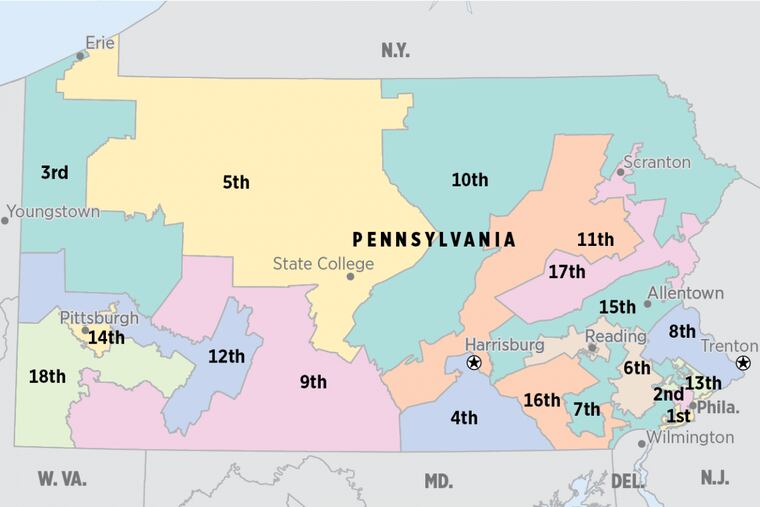A new approach to redistricting in Pennsylvania and beyond | Opinion
It is unrealistic and undesirable for the courts to intervene every time redistricting maps are criticized. A better approach is to embrace two core principles when redistricting is done.

Redistricting is the political buzzword for 2018. A groundswell of recent actions — lawsuits in Pennsylvania and in other states, pending Supreme Court cases, bills introduced in state legislatures and Congress — could transform American politics by changing how legislative redistricting is done.
Redistricting greatly influences who wins elections, which party is in the majority, and which bills become laws. We have ideas for doing it better.
In most states, the legislature controls the redistricting process, which allows the party in power to redraw legislative and congressional maps in ways that sweeten election prospects for their "team" while punishing the opposition party and independent members of their own party. This is called gerrymandering and it isn't new to American politics.
Gerrymandering reached its peak in the wake of the 2010 elections. Typically, in most states, redistricting is done by the legislature, passed as a bill and signed by the governor. There are, however, many variations. In Pennsylvania, this is the process for congressional redistricting. Legislative redistricting, for the Commonwealth House and Senate, is done by a five-person political commission. So, partisanship easily arises.
The Brennan Center found that Pennsylvania is one of three states with the most-distorted congressional redistricting maps. In each of the elections (2012, 2014 and 2016) since Pennsylvania's current redistricting map was adopted, Democrats received about half the votes for Congress but obtained only five of the 18 seats allocated to the Commonwealth.
The map in Pennsylvania is being challenged in the state courts. A lower court found that the map did benefit Republicans, but did not declare the map to be an illegal gerrymander. The State Supreme Court will now consider the matter. The U.S. Supreme Court is hearing challenges to maps in Wisconsin and Maryland.
It is unrealistic and undesirable for the courts to intervene every time redistricting maps are criticized. A better approach is to embrace two core principles when redistricting is done.
1. Eliminate conflicts of interest by taking the politics out of redistricting.
Allowing politicians to control redistricting makes as much sense as asking foxes to guard chicken coops. Politicians have an obvious conflict of interest between seeking partisan goals and serving the public interest in ensuring a government where all votes count equally.
Fortunately, there's a better way to carry out redistricting: Assign the job to independent commissions. Six states have already adopted this approach. California and Arizona are two widely recognized examples. Such commissions are obligated under law to operate in the public interest and in a non-partisan manner.
These commissions work well, in part, because their members are carefully and objectively chosen to not include public officials or current lawmakers, or people connected to them, just like jury selection. Furthermore, meetings are open to the public and proposed redistricting maps are subject to public scrutiny for possible partisanship. This keeps members — and the maps they draw — honest.
2. Publicly and openly consider many alternative redistricting plans.
There is not — nor should there be — any single criterion for choosing the "one best" redistricting map. So, it's important that commissions scrutinize many different alternatives — eliminating any that appear partisan or otherwise defective — if a good decision is to be reached.
Thanks to recent computational advances, redistricting commissions can produce thousands of valid redistricting plans — and can consider computer-generated maps submitted by members of the public as well. Those thousands of plans can then be filtered, looking for those with desirable properties: possessing partisan fairness, for example, or including entire communities of interest such as counties and townships.
Once commissions are created, important issues remain. How can the public be encouraged to propose redistricting plans and participate in assessing them? What is the best way to make data available to members of the public interested in proposing their own maps? What are the desirable properties of a good plan? How can non-partisan civic groups, such as the League of Women Voters and Philadelphia's Committee of Seventy, best be involved? Addressing these and other issues will help to assure that redistricting produces the fairest possible maps.
Unfair partisan advantage is corrosive and should have no role in redistricting. Independent commissions — empowered and required to choose the best possible plans among many different alternatives and to foster healthy public deliberation — can best assure the flourishing of our democracy.
Steve Kimbrough is a professor at The Wharton School of the University of Pennsylvania and a computational decision scientist. His recent book (with HC Lau), Business Analytics for Decision Making, explores solution pluralism for applied decision making. kimbrough@wharton.upenn.edu
Peter Miller received his Ph.D. in political science at the University of California at Irvine. He specializes in redistricting. After a post-doctoral position at Penn, he has competed a Fulbright Fellowship and is now a researcher at UC Irvine. peter.a.miller@gmail.com
Fred Murphy has been involved in public policy development and analysis for over 40 years. He is an Emeritus Professor at Temple University, and has long had an interest in redistricting. fmurphy@temple.edu.